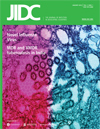Pan-resistant Acinetobacter Infection in Neonates in Karachi, Pakistan.
DOI:
https://doi.org/10.3855/jidc.533Keywords:
Acinetobacter infection, neonate, mortality risk factorsAbstract
Background: Pan-resistant Acinetobacter infection has emerged as an important nosocomial pathogen in our inpatient neonates over the past few years.
Methodology: We performed a retrospective chart review during a five-year period (July 2003 - June 2008) of all neonates hospitalized in our neonatal intensive care unit (NICU) who developed Acinetobacter infection to identify mortality-associated risk factors in Acinetobacter neonatal infection.
Results: During the five-year study period, 122 cultures from 78 neonates grew Acinetobacter. Source sites of positive culture were in the following descending order: blood (n = 57), trachea (n = 55), tissue/wound/body fluids (n = 4), eye (n = 4), urine (n = 1), and cerebrospinal fluid (n = 1). Twenty-four (31%) patients had Acinetobacter isolated from more than one site. At the time of admission the mean age was 2.08 ± 4 days and mean weight was 1.77 ± 0.88 kg; 75% were premature. Pan-resistance (87/122; sensitive only to Polymyxin) was present in 71% of Acinetobacter isolates. Crude mortality rate of this cohort was 47%, while 70% of patients died within four days after positive Acinetobacter culture. We identified weight of less than 1 kg on admission (p 0.06, adjusted Odds Ratio (AOR) 1.53), gestational age 28 weeks or less (p 0.011, AOR 2.88), poor perfusion (p 0.007, AOR 2.4), thrombocytopenia (p 0.01; AOR 1.6) and metabolic acidosis (p 0.01; AOR 1.67) as predictors associated with poor outcome.
Conclusion: Pan-resistant Acinetobacter infection is exceedingly fatal in newborns, particularly in premature and very low-birth weight neonates. Rational antibiotic use and vigilant infection control in NICUs are key to controlling multi-drug resistant Acinetobacter infection and improving clinical outcome.Downloads
Published
How to Cite
Issue
Section
License
Authors who publish with this journal agree to the following terms:
- Authors retain copyright and grant the journal right of first publication with the work simultaneously licensed under a Creative Commons Attribution License that allows others to share the work with an acknowledgement of the work's authorship and initial publication in this journal.
- Authors are able to enter into separate, additional contractual arrangements for the non-exclusive distribution of the journal's published version of the work (e.g., post it to an institutional repository or publish it in a book), with an acknowledgement of its initial publication in this journal.
- Authors are permitted and encouraged to post their work online (e.g., in institutional repositories or on their website) prior to and during the submission process, as it can lead to productive exchanges, as well as earlier and greater citation of published work (See The Effect of Open Access).








